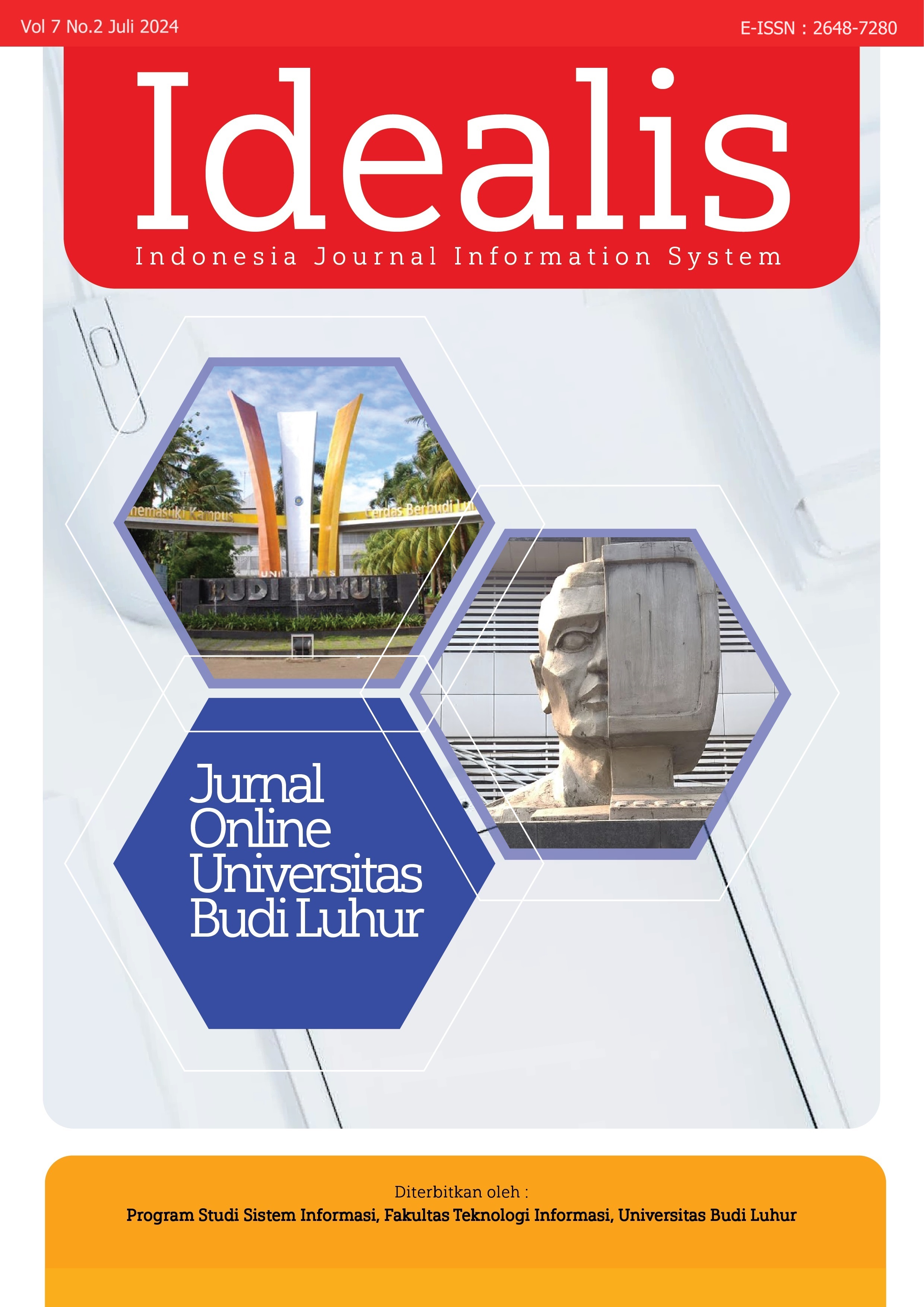FAKTOR-FAKTOR YANG BERPENGARUH UNTUK MEMPREDIKSI TINGKAT KELULUSAN MAHASISWA MENGGUNAKAN ALGORITMA C4.5
Abstract
Factors that influence student graduation to complete studies at university include academic grades, activeness in organizations, school origin, motivation, and busyness in work. This study aims to determine the factors that influence student graduation rates. Based on the calculation results using the C4.5 algorithm, it turns out that the cumulative achievement index (GPA) factor, high school origin, active organization, active student activity unit (UKM), already working and motivation affect student graduation rates both on-time and not. Based on testing using a confusion matrix, accuracy results of more than 70% were obtained, which means that with the C4.5 algorithm, the resulting model can predict well whether students can graduate on time or not with these factors
Downloads
References
[2] C. Dewi, G. E. Laukon, S. A. Sutresno, and ..., “Modification of random forest method to predict student graduation data,” Jurnal …. 2024. [Online]. Available: https://www.ejournal.iocscience.org/index.php/mantik/article/view/4528
[3] M. Delogu, R. Lagravinese, D. Paolini, and G. Resce, “Predicting dropout from higher education: Evidence from Italy,” Econ. Model., vol. 130, no. January 2023, 2024, doi: 10.1016/j.econmod.2023.106583.
[4] H. Pallathadka, A. Wenda, E. Ramirez-Asís, M. Asís-López, J. Flores-Albornoz, and K. Phasinam, “Classification and prediction of student performance data using various machine learning algorithms,” Materials Today: Proceedings, vol. 80. pp. 3782–3785, 2023. doi: 10.1016/j.matpr.2021.07.382.
[5] A. Mailana, A. A. Putra, S. Hidayat, and A. Wibowo, “Comparison of C4.5 Algorithm and Support Vector Machine in Predicting the Student Graduation Timeliness,” Jurnal Online Informatika, vol. 6, no. 1. p. 11, 2021. doi: 10.15575/join.v6i1.608.
[6] U. Pujianto, W. Agung Prasetyo, and A. Rakhmat Taufani, “Students Academic Performance Prediction with k-Nearest Neighbor and C4.5 on SMOTE-balanced data,” 2020 3rd International Seminar on Research of Information Technology and Intelligent Systems, ISRITI 2020. pp. 348–353, 2020. doi: 10.1109/ISRITI51436.2020.9315439.
[7] T. Li, Y. Pan, K. Tong, C. E. Ventura, and C. W. De Silva, “Attention-Based Sequence-to-Sequence Learning for Online Structural Response Forecasting under Seismic Excitation,” IEEE Trans. Syst. Man, Cybern. Syst., vol. 52, no. 4, pp. 2184–2200, 2022, doi: 10.1109/TSMC.2020.3048696.
[8] A. M. Mariano, A. B. De Magalhães Lelis Ferreira, M. R. Santos, M. L. Castilho, and A. C. F. L. C. Bastos, “Decision trees for predicting dropout in Engineering Course students in Brazil,” Procedia Computer Science, vol. 214, no. C. pp. 1113–1120, 2022. doi: 10.1016/j.procs.2022.11.285.
[9] D. Kurniawan, A. Anggrawan, and H. Hairani, “Graduation Prediction System On Students Using C4.5 Algorithm,” MATRIK : Jurnal Manajemen, Teknik Informatika dan Rekayasa Komputer, vol. 19, no. 2. pp. 358–365, 2020. doi: 10.30812/matrik.v19i2.685.
[10] J. R. Almonteros, J. B. Matias, and J. Victoria S. Pitao, “Forecasting Students’ Success To Graduate Using Predictive Analytics,” Int. J. Comput. Digit. Syst., vol. 15, no. 1, pp. 697–711, 2024, doi: 10.12785/ijcds/150151.
[11] A. Alfahid, “Algorithmic Prediction of Students On-Time Graduation from the University,” TEM J., vol. 13, no. 1, pp. 692–698, 2024, doi: 10.18421/TEM131-72.
[12] H. Mukhtar, J. Al Amien, and F. Dewi, “Prediction of Student Graduation Using Decision Tree Method,” PROCEEDING CelSciTech, vol. 5, no. 1, pp. 7–18, 2021.
[13] F. Zhou, L. Xue, Z. Yan, and Y. Wen, “Research on college graduates employment prediction model based on C4.5 algorithm,” Journal of Physics: Conference Series, vol. 1453, no. 1. 2020. doi: 10.1088/1742-6596/1453/1/012033.
[14] K. A. Putri, D. Febriawan, and F. N. Hasan, “Implementation of Data Mining to Predict Student Study Period with Decision Tree Algorithm (C4.5),” J. Sisfokom (Sistem Inf. dan Komputer), vol. 13, no. 1, pp. 31–39, 2024, doi: 10.32736/sisfokom.v13i1.1943.
[15] A. Ramadhanu, S. Defit, and S. W. Kareem, “Hybrid Data Mining with the Combination of K-Means Algorithm and C4.5 to Predict Student Achievement,” International Journal of Artificial Intelligence Research, vol. 5, no. 2. 2021. doi: 10.29099/ijair.v6i1.225.
[16] L. I. P. Aji and A. Sunyoto, “An Implementation of C4.5 Classification Algorithm to Analyze student’s Performance,” 2020 3rd International Conference on Information and Communications Technology, ICOIACT 2020. pp. 126–130, 2020. doi: 10.1109/ICOIACT50329.2020.9332088.
[17] N. A. Prahastiwi, R. Andreswari, and R. Fauzi, “Students Graduation Prediction Based on Academic Data Record Using the Decision Tree Algorithm C4.5 Method,” JURTEKSI (Jurnal Teknologi dan Sistem Informasi), vol. 8, no. 3. pp. 295–304, 2022. doi: 10.33330/jurteksi.v8i3.1680.
[18] A. Buulolo and E. Bu’ulolo, “Implementasi Algoritma Data Mining J48 Untuk Klasifikasi Mahasiswa Yang Layak Mendapat Beasiswa PPA,” Building of Informatics, Technology and Science (BITS), vol. 4, no. 1. 2022. doi: 10.47065/bits.v4i1.1641.
[19] S. Fahriah, N. D. Kamarudin, L. Triyono, and A. Rizaldy, “The Adaboost Integration to the C4.5 Algorithm in Improving Study Interest Classification Accuracy,” Indonesian Journal of Information Systems (IJIS), vol. 6, no. 2. 2024.
Copyright (c) 2024 Dewi Arianti Wulandari, Herman Bedi, Luqman Luqman, Ahmad Arfan Mashuda

This work is licensed under a Creative Commons Attribution-ShareAlike 4.0 International License.













.png)

